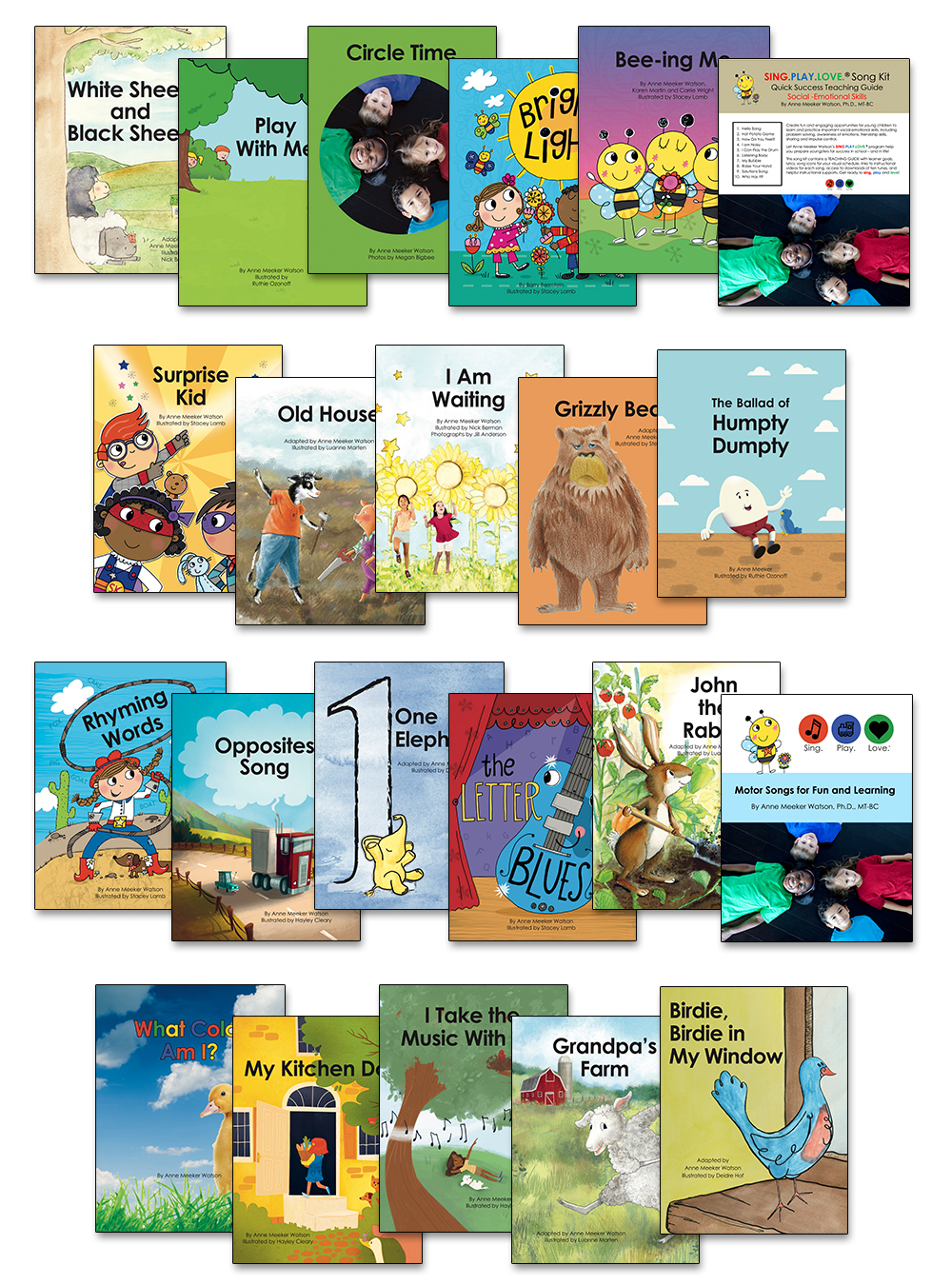How Music Can Help Teachers Support Social-Emotional Health


Music and play aren’t just fun, natural ways for young children to expel their boundless energy; they’re also fantastic opportunities to build key skills across developmental domains, including social-emotional competencies that help prime kids for school success. Designed specifically for use in early childhood learning environments, the SING.PLAY.LOVE.® program is an ideal way to tap into young children’s instinctive love of music and movement and support social-emotional development. This innovative program uses colorful picture books, song downloads, interactive music videos, and printable activity pages to ease stress and anxiety and reinforce critical social-emotional skills like self-regulation.
Joining us this month is SING.PLAY.LOVE. creator and music therapist Dr. Anne Meeker Watson. In this Q&A, she talks about why young children are so responsive to music in the classroom, how music and singing help support peer-to-peer connections, and more.
Q. Music is a unique way to support social-emotional health. What is it about music that lends itself to supporting social-emotional development for young children?
Making music with others is enjoyable—whether singing with gusto, patting your legs to the beat, playing a paint bucket “drum” with a wooden spoon, or waving a bandana in the air as you dance with others. Participating in musical activity helps children self-organize and connect with others. The predictability of the music allows young children opportunities to anticipate what will come next in the song and notice the sounds and movements of their friends. Music can be “instrumental” (pun intended) in helping children find their calm in situations where they are experiencing big emotions.
Q. Why are children so responsive to music when learning in the classroom?
Children are naturally responsive to music. Think about a baby’s reaction when they hear a familiar song. They begin to move their bodies by kicking their feet or clapping their hands. They smile and spontaneously vocalize. Music is a uniquely human experience that helps us calm, engage, express, and joyfully participate. Music communicates what words cannot.
As educators, we often expect young children to listen and respond to lots of spoken words. Music can help children follow directions, engage socially, and share thoughts and ideas. Seldom do I meet a child under five years of age who doesn’t absolutely love music. Teachers can utilize music as an effective tool to teach important things to youngsters. And the children don’t even realize they are learning; they only know they are having fun!
Q. Some children may be more reluctant to join in and sing with the class. Have you found any strategies that work well for engaging these children?

Singing can be challenging, especially for very young children. It requires coordination of the lips, teeth, tongue, and breath to produce a singing sound. The language demands can also be tricky depending on the complexity and tempo of the lyrics. I ask children to sing one repeating word or phrase with me as we learn a new song. We then build upon their mastery of a phrase or two with repetition and practice. They love to master a song and eventually sing their favorites in their entirety—loudly and with enthusiasm!
It is important to offer a variety of ways for youngsters to participate. Share “song pages” that allow children to point to pictures of the animals or objects that are featured in the song. Add dance moves, large and small motor motions, or signed words to your song so they can move to the music. And include instruments from your kitchen shelves or the local dollar store. Children love playing along as they listen to the music.
Q. Self-regulation is an important skill in children’s social-emotional development. How does a group sing-along foster and support young children’s self-regulation skills?
Self-regulation is “the ability to monitor and manage emotions, thoughts, and behaviors to achieve desired outcomes” (Barkley, 2004). According to pediatrician and author Stuart Shanker, it is our task as early childhood professionals to reduce the frequency and intensity of a young child’s big emotions by helping them manage their stress and recovery (2016). Music is shared in every culture to soothe and calm babies. The pulsating beat of a soothing song is thought to mimic the mother’s heartbeat in utero. You hopefully have memories of a favorite lullaby your parent or caring adult sang to you, and you likely sang that same song to your own children.
A teacher’s emotional connection with their young students is essential. The teacher’s consistent and empathetic response to a child’s emotional distress is the pivotal experience that helps children master self- regulation at school. Here are some easy ways to utilize the calming “superpower” of music to help children manage their feelings, thoughts, and emotions.
 Share calming music with children when they have a tough time transitioning into the classroom. This simple routine can help reset the emotional state of the child and make them available to learn and play.
Share calming music with children when they have a tough time transitioning into the classroom. This simple routine can help reset the emotional state of the child and make them available to learn and play.- Embed strategies to help children manage big feelings. Instruct children to close their eyes as they sing and count to ten. Practice breathing deeply as you listen to a quiet song. “Turn off your voices” as you gently move and stretch to an instrumental version of a soothing song.
- Give children the words they need to express sadness, anger, frustration, and fear. Find photos of faces expressing each emotion and ask children to point to the photo matching the feeling they are experiencing. Give them frequent opportunities to label and discuss their own emotions, as well as the emotions of characters in books.
Q. Strong peer-to-peer connections are an important part of healthy social-emotional development. How does singing along help to support peer-to-peer connections in the classroom?
According to author Daniel Pink, making music in a group produces a variety of social-emotional benefits. He examined the effects of making music in a group and found that this act of “synchronizing to the heart” reduced stress, improved mood, enhanced purpose and belonging, and increased sensitivity toward others (Pink, p. 195). Pink also noted that children four to six years of age who engage in prosocial activities—such as playing musical clapping games or dancing together—are kinder and more likely to smile, help others, and initiate play with new friends (Klein, 2019). Pink suggests making group singing mandatory for all school children. Says Pink: “It is more powerful than you could ever imagine.”
Q. Can the SING.PLAY.LOVE. Social-Emotional Learning Kit be used with all children in inclusive classroom settings?
The program benefits every child; in fact, you may observe the program to be uniquely beneficial for some children who have identified special education needs. There are easy ways to foster participation of every child, including visual supports and schedules, predictable routines, multisensory experiences, and engaging content that can be repeated often.
The Social-Emotional Learning Kit helps educators intentionally teach a variety of foundational early learning skills for social and emotional growth by sharing picture books, songs, and play-based activity. The lyrics contain information children can remember and apply across the activities of their day, such as “be safe, respectful, and responsible” or “I am a bright light, perfect just the way I am!” The songs and books give every child language and behavioral strategies to practice that support their emerging emotional literacy, executive function, self-regulation and friendship skills.
Q. Do you recommend that parents sing with their children at home to support social-emotional development when children aren’t in the classroom?

Absolutely! There is no singer in the world that a young child loves more than their parent. It is important to note that toddlers and preschoolers do not judge their parent’s vocal ability. They are truly not tiny “American Idol” judges. Children believe their parents are the best singers in the known universe. They adore being held as mom sways and sings to a favorite song or sitting in dad’s lap as they sing a picture book together.
A child loves when their parent creates new lyrics for familiar melodies. “Here we go ‘round the mulberry bush” can become “here we go ‘round my Timothy’s room!” These simple improvised songs can form a routine that imbeds a variety of social-emotional lessons, such as “this is the way we’re kind to our friends.”
By nurturing and strengthening the parent-child connection with music, youngsters prepare for school success with a strong sense of belongingness and self-worth.
Q. Some teachers may not feel prepared to introduce a sing-along program in their classroom. Do you have resources to help teachers implement the program in their class?

I would like to have a heart-to-heart conversation with any teacher who believes they are not a good enough singer to share their voice with children. We should all take a lesson from our youngsters who model their enjoyment of music with glee from the time they enter the world. Our singing voices are a unique expression of our humanity and are meant to be shared, and not just in the shower or the car when no one is listening! Music is an effective tool for teaching and practicing a variety of skills and is simply too valuable to be omitted from a young child’s day in the classroom.
The best advocates for a music- and play-based program such as SING.PLAY.LOVE. are the children themselves. They will insist on repeatedly and joyfully singing songs and stories. They will spontaneously perform their favorite songs during play centers, snack time, or during outside play. There will also be children who struggle with engagement and are the most successful when singing and dancing with their friends.
Audio recordings and instructional videos for every book and song are included with the kit. Given repeated opportunities to practice, young children will add their voices to the performance. With enough repetition, children and their teachers will want to sing without the recording to create their own verses or take their time singing as they point to pictures on the pages of the books.
Learn More About the SING.PLAY.LOVE. Program
 SING.PLAY.LOVE. Educator Kits
SING.PLAY.LOVE. Educator Kits
Created by Dr. Anne Meeker Watson, the SING.PLAY.LOVE. kits are part of a creative, joyful, and highly-effective program that uses books, music, and play to help young children fall in love with learning—and support their development, too!

